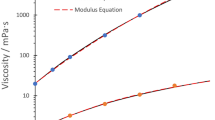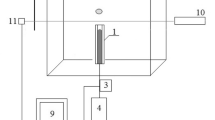Abstract
THE measured tensile strength of water has long been known to be significantly less than theoretical predictions and the reduced strength is normally attributed to the presence of solid impurities that serve as nucleation sites for rupture of the liquid1. A favourite method of measuring tensile strength is through the dynamic stressing of a liquid by an acoustic field. At sufficiently large values of the peak negative acoustic-pressure amplitude the liquid ruptures and forms a rapidly growing vapour cavity that collapses violently during the positive portion of the cycle. This cavity collapse is normally violent enough to be observed easily with the unaided eye or ear. Such an event is termed the acoustic cavitation threshold and is a measure of the tensile strength of a liquid. Although some successes have been obtained in achieving measured values of the tensile strength comparable to theoretical predictions for extremely small samples2 or after extensive filtration3, I know of no current theory for the prediction of values of the dynamic tensile strength for ordinary distilled water. Using a modified version of a recent theory by Apfel4, an equation is presented here that correctly predicts the variation of the acoustic cavitation threshold of water with surface tension, dissolved gas content and temperature.
This is a preview of subscription content, access via your institution
Access options
Subscribe to this journal
Receive 51 print issues and online access
$199.00 per year
only $3.90 per issue
Buy this article
- Purchase on Springer Link
- Instant access to full article PDF
Prices may be subject to local taxes which are calculated during checkout
Similar content being viewed by others
References
Harvey, E. N. et al. J. cell. comp. Physiol. 24, 1 (1944).
Apfel, R. E. Nature 233, 119–121 (1971).
Greenspan, M. & Tschiegg, C. J. Res. NBS 71 C, 299–312 (1967).
Apfel, R. E. J. acoust. Soc. Am. 48, 1179–1186 (1970).
Crum, L. Tech. Rept. No. 178 (Michelson Phys. Lab. U.S. Naval Academy, 1978).
Strasberg, M. J. acoust. Soc. Am. 31, 163–176 (1959).
Bargeman, D. & Van Voorst Vader, F. J. Coll. Sci. 42, 467–472 (1973).
Bargeman, D. J. Coll. Sci. 40, 344–348 (1972).
Adamson, A. W. Physical Chemistry of Surfaces, 113–139 (Interscience, New York, 1967).
Furmidge, C. G. L. J. Coll. Sci. 17, 309–324 (1962).
Galloway, W. I. J. acoust. Soc. Am. 26, 849 (1954).
Crum, L. A. & Nordling, D. A. J. acoust. Soc. Am. 52, 294–301 (1972).
Esche, R. Acustica 2, AB208–AB218 (1952).
Lauterborn, W. Acustica 22, 48–53 (1969).
Author information
Authors and Affiliations
Rights and permissions
About this article
Cite this article
CRUM, L. Tensile strength of water. Nature 278, 148–149 (1979). https://doi.org/10.1038/278148a0
Received:
Accepted:
Published:
Issue Date:
DOI: https://doi.org/10.1038/278148a0
This article is cited by
-
Temperature Dependence of the Tensile Strength of Select Coolant Materials for Generation-IV Nuclear Reactors: Sodium, Lead and Bismuth
JOM (2023)
-
Understanding the formation of gas bubbles at liquid–liquid interfaces
Nature Physics (2022)
-
Heterogeneous cavitation from atomically smooth liquid–liquid interfaces
Nature Physics (2022)
-
Gas-stabilizing nanoparticles for ultrasound imaging and therapy of cancer
Nano Convergence (2021)
-
The height limit of a siphon
Scientific Reports (2015)
Comments
By submitting a comment you agree to abide by our Terms and Community Guidelines. If you find something abusive or that does not comply with our terms or guidelines please flag it as inappropriate.



